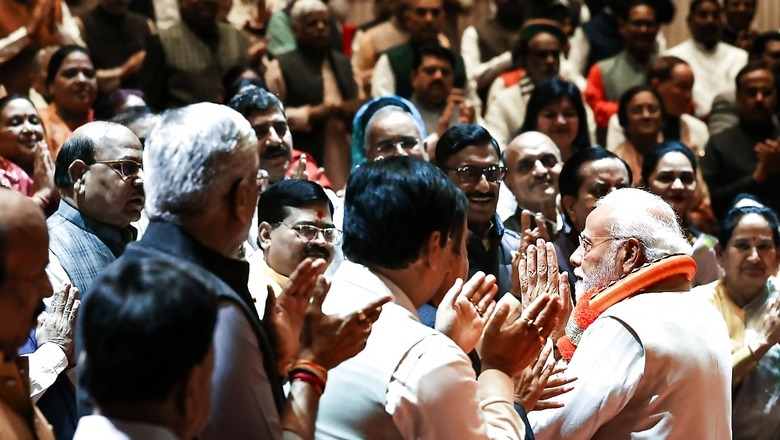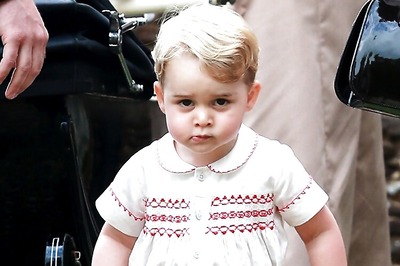
views
On December 4, just a day after election results were out, the prime minister — probably for the first time — articulated in clear terms: “When there is good governance, the word anti-incumbency becomes irrelevant.” He said some call it ‘pro-incumbency’, while others label it ‘good governance’. While PM Modi’s detractors may have construed it as a trump speech, the man doesn’t utter words without evidence.
On Thursday, the prime minister backed up his claim with proof. It was a regular BJP parliamentary party meeting ahead of the session which turned out to be a “master class” in politics, a word used by a sitting Union minister while describing the experience.
MODI GIVES PROOF OF PRO-INCUMBENCY
PM Modi entered the meeting with facts and data. He was contrasting the BJP and Congress — the prime opposition party. He said of the 40 times that the Congress faced assembly election after one term, in relatively recent electoral history, they could make a comeback only seven times. The success rate is below 20 per cent, in fact, just 18 per cent.
Next, the prime minister told the BJP Members of Parliament that of the recent 39 times the BJP faced assembly election after one term, in relatively recent electoral history, it made a comeback 22 times. The success rate is a whopping 56 per cent. To put things into perspective, that is more than three times the Congress’s strike rate.
Two figures — 22 and 7— were used by the prime minister to make his point, said an MP from West Bengal. He told News18 that Modi was not ridiculing the Congress but was underlining BJP’s success.
However, PM Modi did not stop at convenient comparisons with the Congress alone. A sitting minister at the Centre said he compared the BJP’s performance with regional parties like the Biju Janata Dal (BJD) in Odisha or Trinamool Congress (AITC), without naming any specific parties when it comes to beating anti-incumbencies.
Of 36 assembly elections in recent times, the regional parties won 18, giving them a strike rate of 50 per cent — still lagging behind the BJP. “Don’t forget the parties are coming back to power in one state unlike the BJP which is beating anti-incumbencies in many states,” said the Bengal MP, highlighting why BJP’s figure was far more significant than that of regional parties.
Summing up, the prime minister said the numbers were evidence that BJP is the most preferred party in India.
However, he did not take the credit for it, regardless of the fact that it is his face and brand value that helped the BJP achieve this feat. On the contrary, he stressed “team spirit” that includes cadre and the prime minister alike. If pro-incumbency is a reality, its biggest reason — PM Modi — called for a more equitable distribution of credit.
GOOD GOVERNANCE = PRO-INCUMBENCY?
On December 4, PM Modi almost equated ‘good governance’ with ‘pro-incumbency’. He said: “When there is good governance and consistent support for public welfare, the term ‘anti-incumbency’ becomes irrelevant. Some may call it pro-incumbency, good governance, transparency, national interest, or solid plans for public welfare, but this has been the experience that we have been witnessing consistently”.
Let’s look at recently concluded state elections. The BJP came to power in three of which it already held Madhya Pradesh. It swept back to power for the fifth time with a massive tally of 163 seats out of a total of 199. Ticket distribution and electoral promises were two of the reasons development projects like water connections and irrigation helped the BJP. Making tribal communities aware of the implementation of the Panchayat (Extension to Scheduled Areas) or PESA Act helped the BJP gain tribal votes as well. The Ladli Behna Yojna — something the BJP refuses to call a freebie but insists is a welfare project — swung the election for the party in Madhya Pradesh. Collectively, this is what Modi refers to as ‘good governance’.
The biggest election in the Hindi heartland of late was in Uttar Pradesh in 2022. The BJP’s return to power in Uttar Pradesh last year by a commanding majority—and despite strong caste-based alliances by the Samajwadi Party (SP) — was largely credited to the party’s welfare schemes again.
An article by the Institute of South Asian Studies observed, “…the welfare schemes of the BJP government, including direct benefit transfers and free rations, paid electoral dividends. The schemes not only attracted voters from all classes but also possibly helped the BJP cut across caste divisions to some extent, creating what some have termed a labharthi (beneficiary) voting bloc”.
The party swept back to power despite distress caused by Covid-19 as the have-nots received regular ration from both the Centre and the state during the pandemic and even later on.
A year before UP, BJP swept back to power in North East’s most important state — Assam. BJP’s worry was the formation of a grand alliance of eight parties to consolidate anti-BJP votes. Yet, the party beat anti-incumbency.
While it would be naive to point at a ‘polarised’ election, the truth is welfarism. Initiatives such as the Arogya Nidhi were a bumper hit in Assam. The number of beneficiaries under various schemes such as ‘Orunodai’ under the National Food Security Act also went up substantially. In 2021 Assam, you name a segment of society and there was a scheme for them, including women from religious minorities.
Nationally, as India is about to enter 2024 — the year of Lok Sabha election — the reason of Modi’s and hence BJP’s popularity remains some of the central schemes. One of them certainly is ‘Nal se Jal’ or piped water connection where, as of today, 13,75,22,096 households — more than 71 per cent Indian houses — are connected to piped water. In 2019, when the scheme started, the number was 3,23,62,838 — a little over 16 per cent.
PM Awas Yojna, in urban areas alone, has completed 78.27 lakh houses, gifting the urban poor what they could only dream of. Under the UJALA Scheme, more than 36.78 crore LEDs have been distributed across the country at cheaper rates. UJALA succeeded in bringing down the retail price of LED bulbs from Rs 300-350 per bulb to Rs 70-80 per bulb.
But the mother of all schemes came during the pandemic. In 2020, a relief package worth Rs 1.70 lakh crore was announced to tackle the financial difficulties that were faced due to the Covid-19 outbreak under the PM Garib Kalyan Yojana. It put food on the plates of the hungry during a bleak time.
Collectively, these were some of the schemes that the prime minister intended to mention when he referred to the term ‘good governance’. It was this ‘good governance’ he wanted to underline to his colleagues in Parliament when he proudly claimed that the schemes helped the BJP have a success rate of 56 per cent of coming back to power in state elections.
And, probably, it is this ‘good governance’ that gives the prime minister confidence to come back to power in the Centre in 2024. When he repeatedly says “poverty is the biggest caste”, he has his eyes fixed on ‘good governance’ which translated to ‘pro-incumbency’.
















Comments
0 comment